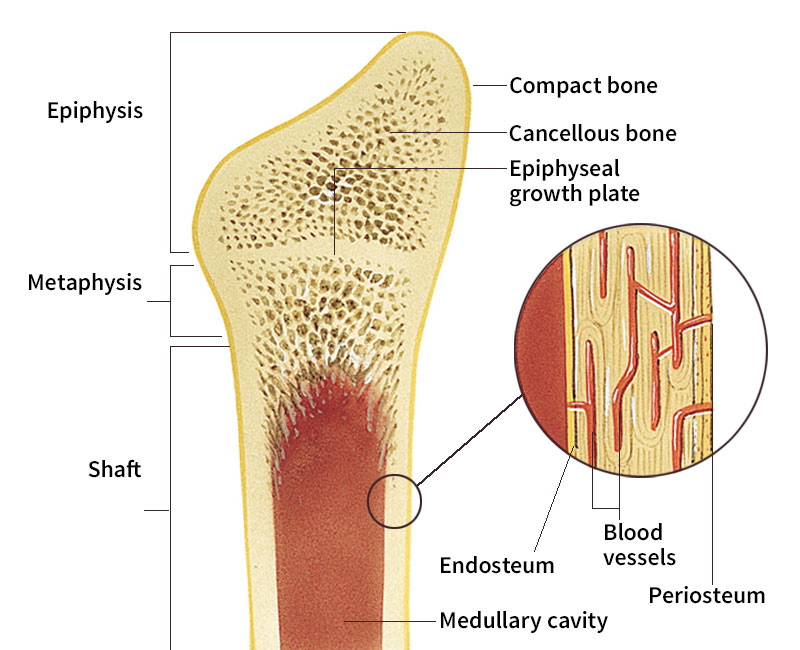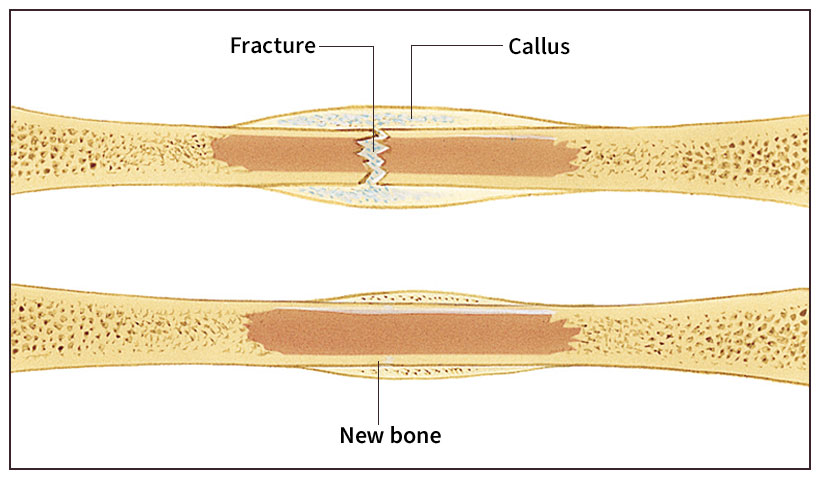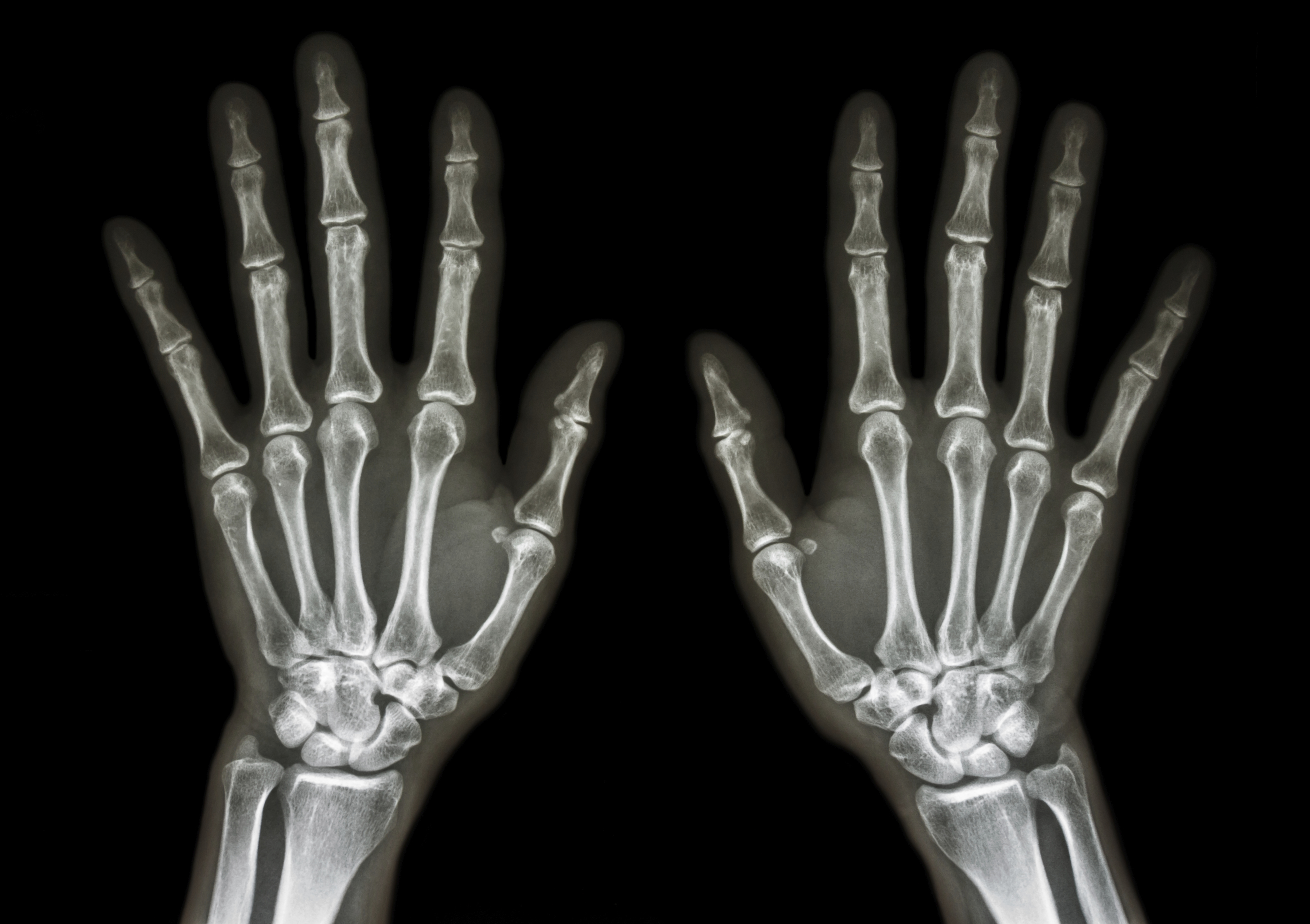Bone is a hard substance that forms the framework of the bodies of animals with backbones, including human beings. The separate parts of this framework are called bones. A smooth material called cartilage makes up the ends of long bones. The junctions between neighboring cartilage surfaces, which are surrounded by ligaments (fibrous tissues), are referred to as joints.
Each bone and each joint have a name. For example, the bone of the upper arm is called the humerus, the bones of the forearm are known as the radius and the ulna, and the joint formed by these bones is the elbow. Some bones are closely attached to one another in groups and form a special structure, such as the skull.
Bones give shape to the body. They support the body and protect its vital organs. Bone also stores such minerals as calcium, phosphate, and sodium and releases them into the body as needed. All the bones, joints, and special groups of bones make up the skeleton. Muscles and tendons move the skeleton and all its parts. Bones, ligaments, muscles, and tendons together are called the locomotor or musculoskeletal system.
Bone is one of the most active tissues of the body. The body constantly breaks down bone and rebuilds it in a process called bone turnover. About 3 percent of bone in children is broken down and rebuilt each year. Turnover proceeds at a lower rate in adults, but it continues throughout life. In adults, bone turnover makes slightly less bone than it breaks down. Thus, turnover in adults leads to gradual, progressive bone loss.
Structure of the bones.
Most bones have solid, hard tissue called compact or cortical bone on the outside and spongy, honeycombed cancellous or trabecular bone on the inside. Cancellous bone supports the ends of bones and transfers weight from the ends to the central part of the bone. Compact and cancellous bone occur in different proportions in different parts of the skeleton. There is much cancellous bone at the ends of long bones, in the pelvis, and in the upper portion of the femur (thigh bone). Other bones with much cancellous bone include the vertebral bodies (weight-bearing portions of the spine). In the front of the skull, air-filled cavities called sinuses replace the cancellous bone.

Bones are covered on the outside by a fibrous membrane, the periosteum, and lined inside by the endosteum. The center of a bone, called the medullary cavity, is filled with either red or yellow bone marrow. Yellow bone marrow consists mostly of fat. Red bone marrow is a network of blood vessels, connective tissue, and blood-forming cells. Red bone marrow makes red blood cells. All bones have blood vessels and nerves.
Long bones have three parts: (1) the diaphysis << dy AF uh sihs >> , (2) the metaphysis << meh TAF uh sihs >> , and (3) the epiphysis << ih PIHF uh sihs >> . The diaphysis, also called the shaft, is the long central part of the bone. The metaphysis is the flared area near the end of the bone. The epiphysis is the rounded end.
Development of bones.
Bones begin to develop long before birth. A process called intramembranous bone formation creates the top of the skull. In this process, bone directly replaces soft connective tissue. Long bones develop by a process called endochondral bone formation, in which cartilage replaces soft connective tissue and bone, in turn, takes the place of cartilage.
Long bones grow by means of a structure called the epiphyseal growth plate. The growth plate is a thin disk of cartilage between the metaphysis and epiphysis. A new layer of bone successively replaces each layer of cartilage in a process called intracartilaginous bone formation. In this way, the growth plate and epiphysis grow away from the central part of the bone and the shaft gradually grows longer. The growth plate functions throughout childhood and adolescence and stops functioning when a person reaches adult height.
Composition of bone.
About two-thirds of the weight of bone tissue consists of minerals, mostly calcium, phosphate, and carbonate. The rest is organic material, largely the fibrous protein collagen. When boiled in water, collagen yields gelatin. If a long bone is soaked in acid, the mineral matter dissolves and the organic part becomes so soft that it can be tied in a knot. The non-mineral component of bone, containing collagen and other protein substances, is called the bone matrix.
Bone tissue contains three kinds of specialized cells: (1) osteoblasts, (2) osteocytes, and (3) osteoclasts. Osteoblasts form bone matrix by laying down collagen fibers and other proteins and depositing hard mineral material. Osteocytes are osteoblasts that have become trapped in the bone matrix they manufactured and live embedded there for years. Osteocytes help to control the mineral balance of the body and also respond to the stresses created by physical activity. Osteoclasts erode the matrix during normal bone turnover, during growth, and during the healing of fractures.
Broken bones.
When a bone breaks, a doctor should set it as soon as possible and put it in a plaster cast if necessary. The cast holds the bone securely in place. When a bone breaks into several pieces, doctors may wire or pin the pieces together for proper healing. In most cases, the body forms a fracture callus, a mass of new cartilage and bone, to hold the broken ends together. New bone gradually replaces the callus to finally heal the fracture. This process takes from four weeks to a year, depending on the size of the bone, the location of the fracture, and the patient’s age and health. In some cases, the break does not heal by itself. Doctors treat such nonunion fractures with bone grafts or with electrical current to stimulate bone growth.

Bone disorders.
The most common bone disorder is senile osteoporosis, which means porous bones of old age. Osteoporosis results when the loss of bone tissue that comes with aging weakens the bones and makes them prone to fracture. Exercise helps strengthen bones.

An insufficient supply of calcium, phosphate, or vitamin D in the body causes a person’s bones to soften. This condition is called rickets in children and osteomalacia in adults. Osteitis fibrosa is the destruction of bone by osteoclasts. It is caused by overactivity of the parathyroid glands, which release a hormone that stimulates osteoclasts to erode bone.
